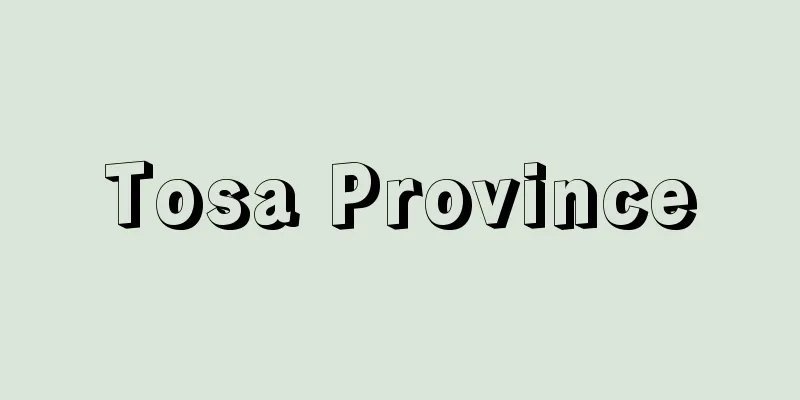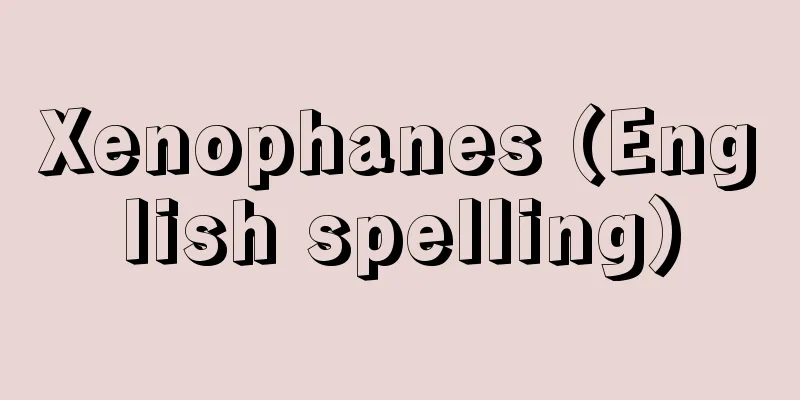Tosa Province

|
An old name of a province facing the Pacific Ocean in southern Shikoku. It belongs to the Nankaido. It is currently Kochi Prefecture. It was also known as Takeyorowake (Kojiki), and in ancient times it was written as Tsusa or Tosa. Jomon ruins are more prevalent in the west, while Yayoi ruins are more prevalent in the east. Kofun tombs are concentrated in the southern part of Nagaoka County in the central east. The Kujihongi records that Amenokarasomikoto was the kuni no miyatsuko of Hata, and Hiji no Sukune was the kuni no miyatsuko of Tsusa. A major earthquake on October 14, 684, the 13th year of Emperor Tenmu's reign, caused an area of over 500,000 m2 (12 square kilometers) to sink into the sea (Nihon Shoki). Administrative divisions were established, and four districts, Hata, Agawa, Tosa, and Aki, were established. By the early Heian period, three new districts, Takaoka, Nagaoka, and Kagami, were added, bringing the total to seven districts. The Wamyōshō lists 43 townships under the seven districts. The provincial capital was placed in Nagaoka district, and the visit of Ki no Tsurayuki is well known. In 724 (Jinki 1), it was designated a province of exile, but notable figures who were exiled to Tosa included Ki no Natsui, Fujiwara no Moronaga, Minamoto no Mareyoshi, Emperor Tsuchimikado, and Prince Takanaga. In 718 (Yoro 2), the official road to Tosa was changed from entering through Sanuki (Kagawa Prefecture) or Iyo (Ehime Prefecture) to entering through Awa (Tokushima). The Engishiki states that the journey took 35 days for the uphill route and 18 days for the downhill route, and 25 days for the sea route. The Engishiki states that the rice tax was "20,000 bundles each for the public offices and taxes," and silk, dried fish, and silk were paid as taxes. There are 21 shrines listed in the Engishiki, about half of which are concentrated in the Kacho Plain in Kochi. Among the ancient temples, Chikurin-ji Temple (Kochi City) and Buraku-ji Temple are said to have been established by Gyoki, and many temples have legends that they were founded by Kukai. With the development of manors during the Heian and Kamakura periods, the system of 7 counties and 43 villages was modified, and major manors such as Murotsu, Nahari, Tano, Yasuda, Wajiki, and Aki in Aki county, Yasu, Oosato, Monobe, Yoshihara, and Tamura in Kami county, Katayama, Kera, and Agahashi in Nagaoka county, Ichinomiya, Kamobe, Kanda, and Asakura in Tosa county, Agawayama in Agawa county, Takaoka, Hasuike, and Tsuno in Takaoka county, and Hata in Hata county were established. With the establishment of the Shugo Jito system, Kajiwara Tomokage, Sasaki Tsunetaka, Toyoshima Tomotsune, Miura Yoshimura and others became Shugo, but by the end of the Kamakura period they were returned to the hands of the Hojo clan. Famous Jito were Kosokabe of Soga and Fukabuchi districts in Kami County, Chosokabe of Nagaoka County, and Tsuno of Takaoka County. Since the civil war of the Northern and Southern Courts, the area became a Shugo territory for the Hosokawa clan, and Hosokawa clan members Yorimasu, Mitsumasu, Mochimasu, and Katsumasu ruled the country as Shugodai from Tamura Manor. After the Onin War (1467-77), many warlords divided the country, and the Aki, Kosokabe, Yamada, Motoyama, Chosokabe, Kira, Ohira, and Tsuno clans fought each other, but in 1575 (Tensho 3), Chosokabe Motochika unified the country. In 1468 (Onin 2), Ichijo Norifusa moved to Nakamura in his own territory of Hatasho, paving the way for the manor to become an urban area. Four generations passed through the Ichijo clan, including Fusaie, Fusafuyu, Fusamoto, and Kanesada, but Kanesada was exiled by the Chosokabe clan, and his son Tadamasa also rebelled against Motochika, leading to the demise of the Ichijo clan. After unifying Tosa, Motochika conquered Shikoku, but was defeated by Toyotomi Hideyoshi in 1585 (Tensho 13), and was granted control of the entire Tosa province, and devoted himself to managing the country. The results of this were the Code of Laws (Chosokabe Motochika's 100 Articles) and the Land Inspection Record (a nationally designated important cultural property), and he also left behind a legacy that could be called the Okou culture (Okou was the castle grounds of the Chosokabe clan, and is now Nankoku City). After the Battle of Sekigahara, Yamauchi Kazutoyo became the ruler of the province and built Kochi Castle. The Yamauchi clan ruled for 16 generations until Toyonori took over the domain in 1859 (Ansei 6). During that time, 75 laws were established in 1612 (Keicho 17), and the Genroku Ojomoku was established in 1690 (Genroku 3), stipulating the policy of governance according to domain law. In the early days of the domain's administration, Nonaka Kenzan demonstrated his skills and solidified the foundations of domain administration. Nangaku, which is said to have originated under the protection of the Kira clan during the Tenbun era (1532-1555), developed as the Ansai school of learning and the Tani school of learning, and influenced the pro-imperial movement in Tosa at the end of the Edo period. At the end of the Edo period, such patriots as Zuizan Takechi, Ryoma Sakamoto, Shintaro Nakaoka, and Torataro Yoshimura were active and became the driving force behind the Meiji Restoration. In 1871 (Meiji 4), Kochi Domain was renamed Kochi Prefecture, which exists to this day. [Yamamoto Dai] "History of Kochi Prefecture" by Dai Yamamoto (1969, Yamakawa Publishing) " "Kochi Regional History Research Group, ed., "Chronology of Kochi Prefecture History" (Kochi City Library, Shimin Shinsho)" [Reference item] |Pole fishing for skipjack tuna (matsuuo). 1855 (Ansei 2). National Diet Library . Hiroshige Utagawa "Illustrated Guide to Famous Places in the Sixty-odd Provinces: Tosa, Sea..." Source: Shogakukan Encyclopedia Nipponica About Encyclopedia Nipponica Information | Legend |
|
四国南部の太平洋に面した旧国名。南海道に属す。現在の高知県。建依別(たけよりわけ)の別名があり(古事記)、古くは都佐、土左と書かれた。縄文遺跡は西部に多く、弥生(やよい)遺跡は東部に多い。古墳は中東部の長岡郡南部に集中する。天韓襲命(あめのからそのみこと)が波多(はた)の国造(くにのみやつこ)、小立足尼(ひじのすくね)が都佐の国造であったと『先代旧事本紀(くじほんぎ)』には記す。天武(てんむ)天皇13年(684)10月14日の大地震で50余万頃(しろ)(12平方キロメートル)が海没したという(日本書紀)。行政区画が定まり、幡多(はた)、吾川(あがわ)、土佐、安芸(あき)の4郡が設置、平安初期ごろまでに高岡、長岡、香美(かがみ)の3郡が新設されて7郡となる。『和名抄(わみょうしょう)』には7郡の下に43郷が記されている。国府は長岡郡に置かれ、紀貫之(きのつらゆき)の来任は有名。724年(神亀1)遠流(おんる)の国と定まったが、紀夏井(なつい)、藤原師長(もろなが)、源希義(まれよし)、土御門(つちみかど)上皇、尊良(たかなが)親王らは土佐へ配流された著名人である。土佐への官道は718年(養老2)、讃岐(さぬき)(香川県)、伊予(いよ)(愛媛県)から入るのを阿波(あわ)(徳島)から入るように改める。『延喜式(えんぎしき)』には上り35日下り18日、海路25日とみえ、田租は「正税公廨(くがい)各廿万束」とあり、調として帛(はく)、堅魚(かつお)、絹などが上納されている。「延喜式内社」は21社で、約半分は高知・香長(かちょう)平野に集中、古代寺院では、竹林(ちくりん)寺(高知市)、豊楽(ぶらく)寺などは行基(ぎょうき)が開いたといわれ、空海(くうかい)開基の伝承をもつ寺も多い。 平安・鎌倉時代の荘園(しょうえん)の発達により7郡43郷の制は改変され、安芸郡の室津(むろつ)・奈半利(なはり)・田野・安田・和食(わじき)・安芸、香美郡の夜須(やす)・大忍(おおさと)・物部(ものべ)・吉原(よしはら)・田村、長岡郡の片山・介良(けら)・吾橋(あがはし)、土佐郡の一宮(いっく)・鴨部(かもべ)・神田(こうだ)・朝倉、吾川郡の吾川山、高岡郡の高岡・蓮池(はすいけ)・津野、幡多郡の幡多などのおもな荘園が成立した。守護地頭の設置で梶原朝景(かじわらともかげ)、佐々木経高(つねたか)、豊島朝経(ともつね)、三浦義村(よしむら)らが守護となったが、鎌倉末期には北条氏の手中に帰した。地頭では香美郡宗我(そが)・深淵(ふかぶち)郷の香宗我部(こうそがべ)、長岡郡の長宗我部(ちょうそがべ)、高岡郡の津野らが有名。南北朝の内乱以来、細川氏の守護領国となり、細川一族の頼益(よります)、満益、持益、勝益が守護代として田村荘にあって国内を支配した。応仁(おうにん)の乱(1467~77)後、群雄が割拠し、安芸、香宗我部、山田、本山(もとやま)、長宗我部、吉良(きら)、大平(おおひら)、津野らの諸氏が争ったが、1575年(天正3)長宗我部元親(もとちか)が国内を統一した。1468年(応仁2)一条教房(のりふさ)は自領の幡多荘中村に移り荘園から都市化への道を開いた。房家(ふさいえ)、房冬、房基、兼定(かねさだ)と4代を経たが、兼定は長宗我部氏に追放され、子内政(ただまさ)も元親に反し一条氏は滅んだ。元親は土佐統一後四国を制覇したが、1585年(天正13)豊臣(とよとみ)秀吉に敗れ土佐一国を安堵(あんど)され、国内の経営に専念した。掟書(おきてがき)(長宗我部元親百箇条)や地検帳(国指定重要文化財)はその成果であり、そのほか岡豊(おこう)文化ともいえる遺産を残した(岡豊は長宗我部氏の城地、現南国(なんこく)市)。 関ヶ原の戦い後山内一豊(やまうちかずとよ)が国主となり高知城を築く。山内氏は1859年(安政6)の豊範(とよのり)襲封まで16代を数えるが、その間1612年(慶長17)には75か条の法令を定め、90年(元禄3)には「元禄大定目(げんろくおおじょうもく)」が定められ藩法による統治方針が規定された。藩政初期には野中兼山(けんざん)が手腕を振るい藩政の基礎が固まった。天文(てんぶん)年間(1532~55)吉良氏の保護下に発祥したといわれる南学(なんがく)は、闇斎(あんさい)学・谷派の学問として発展し、幕末土佐の勤王運動に影響を及ぼした。幕末には武市瑞山(たけちずいざん)、坂本龍馬(りょうま)、中岡慎太郎(しんたろう)、吉村虎太郎(とらたろう)らの志士が活躍し、明治維新への原動力となった。1871年(明治4)高知藩を改め高知県となり今日に至る。 [山本 大] 『山本大著『高知県の歴史』(1969・山川出版社)』▽『高知地方史研究会編『高知県歴史年表』(高知市民図書館・市民新書)』 [参照項目] |カツオ(松魚)の竿釣り。1855年(安政2)国立国会図書館所蔵"> 歌川広重『六十余州名所図会 土佐 海上… 出典 小学館 日本大百科全書(ニッポニカ)日本大百科全書(ニッポニカ)について 情報 | 凡例 |
<<: Collection of Tosa Province Kanji - Tosa no Kuni tokanshu
Recommend
Inami [town] - Inami
A former town in Higashitonami County in western T...
Gill-breathing circulatory system
...In amphibians, only the atrial septum is forme...
Gawaji - Gawaji
... The Delta region is the so-called Masri (Egyp...
Administrative Criminal Law - Gyosei Keiho
...Special criminal laws, such as the Law on Puni...
Closure - Finish
A type of informal Noh performance. It is perform...
Voronezh - Voronezh (English spelling)
The capital of Voronezh Oblast in the western par...
Czechoslovakia - Czechoslovakia (English spelling)
A country that existed in the center of Europe. F...
Erik
…In 1363, she married Haakon VI of Norway, and in...
Kabure tribe - Kabure tribe
...North of the town of Sokode in the center of t...
Tilapia - tilapia (English spelling)
A general term for the African lineage of the Cic...
Thalassemia
Hemolytic anemia caused by a genetic defect and ba...
Enagarasu - Enagarasu
…He first studied in Vienna, then organic chemist...
Il Cafe - Il Cafe
…He was born into an aristocratic family in Milan...
Ando Sekiten
At the Yalta Conference in February 1945, the All...
Austrian Marxism - Austrian Marxism (English spelling) Austro‐marxismus
Austrian Marxism is a Marxist current that develop...









